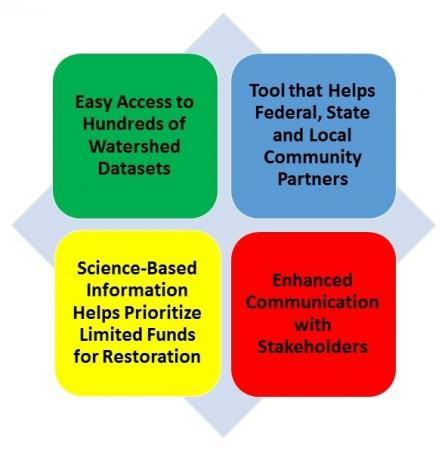Benefits of the Watershed Index Online (WSIO)

- WSIO's Data on Watershed Conditions Helps Restore and Protect the Nation's Waters
- WSIO Helps State and Local Partners Share Costs and Better Allocate Resources
- WSIO Provides Environmental Indicators Relevant to Water Quality
- Customizable WSIO Can Be Applied to a Wide Variety of Tasks
More Information on EPA and Watersheds
WSIO's Data on Watershed Conditions Helps Restore and Protect the Nation's Waters
The Clean Water Act’s primary goal is to restore and maintain the integrity of the nation’s waters. Despite this law’s many pollution control successes, tens of thousands of streams, rivers and lakes have been reported as still impaired. The great majority of these involve pollution sources in their watersheds -- the land area that surrounds and drains into these waters.
Understanding the conditions in watersheds is crucial for restoring areas with degraded water quality, as well as for protecting healthy waters from emerging problems before expensive damages occur. Achieving the Clean Water Act’s main goal depends on having good information about watersheds -- their environmental conditions, possible pollution sources, and factors that may influence restoration and protection of water quality. EPA is investing in developing WSIO from scientifically sound and consistent sources, and making this information public and easily accessible to the wide variety of our partners working toward clean and healthy waters.
WSIO Helps State and Local Partners Share Costs and Better Allocate Resources
EPA has substantial responsibilities under the Clean Water Act, and implements these by working closely with states, authorized tribes and territories. Further, EPA assists and partners with a wide variety of other local- to national-scale partners that include communities, local agencies, non-governmental organizations, corporations, and other federal agencies that are involved in activities to improve or protect water quality.
Although these partners are involved in a very wide variety of activities, watershed information and some form of comparative assessment is typically a crucial part. Often, they must make hard decisions about where to invest limited efforts and funds among more problem areas than they can address. EPA’s development of WSIO helps leverage limited budgets by centrally compiling and providing watershed information key to local and state decisions and actions. Partners are able to spend less on data development, leaving more resources available to improve water quality.
WSIO Provides Environmental Indicators Relevant to Water Quality
Although more and more national datasets on environmental characteristics have become available, few transform information into factors most relevant to water quality. For example, a national dataset showing the presence of agriculture may have some value in recognizing possible sources of water pollution. However, translating this data into watershed indicators, such as the percentage of agriculture on steep slopes or close to streams, is necessary to discern potential risks from non-risk situations.
WSIO makes data more useful by measuring water-quality-relevant indicators on a watershed-by-watershed basis. These indicators include hundreds of ecological, stressor, and social characteristics of watersheds that may improve or degrade water quality.
In addition, most national datasets require knowledge of advanced GIS skills and software, which substantially reduces the number of potential users. By transforming these data into simple watershed indicators, and then making them accessible in a common spreadsheet application (Excel) coded to calculate indices for watershed comparison, WSIO opens the door to a larger audience of users. Moreover, the WSIO Tool generates rank-ordered tables, graphs and simple maps that can be customized for presentations and reports.
Customizable WSIO Tools and Data Can Be Applied to a Wide Variety of Tasks
For many reasons, the WSIO is not a ‘one size fits all’ analytical tool. There are countless purposes for wanting to compare watersheds and make better-informed decisions. In addition, different parts of the nation have very different environments. Building in the ability of WSIO users to customize their tool, and their analysis, was crucial. In particular, WSIO users get to define their own geographic area of interest, then choose the indicators most relevant to it. They can weight the indicators differently if desired. What’s more, users are not limited to the WSIO indicator library; they can add more indicators to their custom tool from outside sources. The end result is a flexible, public source of relevant data and tools that can be tailored to a wide variety of efforts to restore and maintain healthy waters across the nation.
More Information on EPA and Watersheds
- Introducing WSIO – a more detailed account of the approach, purpose, development, and characteristics of WSIO.
- Recovery Potential Screening – an EPA comparative watershed assessment tool utilized by many state water programs to set priorities for restoration. This project contributes to and utilizes WSIO indicator data, and provided the framework for the WSIO tool’s development.
- Healthy Watersheds Protection – an EPA program dedicated to assessing and protecting waters and watersheds before they become severely degraded. Its assessments use many of the indicators compiled in WSIO to describe watershed health and vulnerability.
- EPA EnviroAtlas – an EPA research program website that documents ecological goods and services of watersheds nationally. This project contributes to and utilizes WSIO indicator data.
